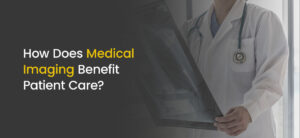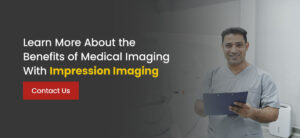
Medical imaging is one of the most critical developments in the history of medicine. Its discovery has led to multiple Nobel Prize achievements. The Nobel Prize was awarded to the founder of radiology in 1895 and the inventors of computerized tomography (CT) scans in 1979. More importantly, it has also improved the lives of countless individuals. Medical imaging improves patient outcomes, helps doctors understand patient conditions better and confers several other benefits.
In what follows, you can see some specific medical imaging benefits with patient care in greater detail.
Improve Patient Outcomes
Medical imaging improves patient outcomes by making earlier detection possible and increasing diagnostic accuracy. Patient outcomes refer to the long-term success of treatments and how they improve, worsen or have no effect on patient conditions. They also measure patient satisfaction, recovery times and treatment efficiency.
One of the ways patients experience better outcomes with medical imaging is through preventive care. For example, mammography is the gold standard for detecting early signs of breast cancer. Mammography uses low-dose X-ray technology to detect cancer cells inside breast tissue before they spread. A 2020 study of over 500,000 women found that those who take part in mammography screening reduce their risk of dying of breast cancer by 41%.
Another way medical imaging improves patient outcomes is by reducing the need for invasive surgical procedures. With image guidance technology, doctors can perform complex surgeries through smaller incisions. Less invasive surgeries improve patient outcomes in several ways:
- Reduced risk of infections: As minimally invasive surgeries expose less of the patient’s organs and soft tissues, they also reduce the risk of surgical site infections (SSIs). SSIs occur when pathogens multiply at the surgery site, leading to an infection. With that in mind, smaller surgical sites give fewer opportunities for pathogens to cause infections.
- Smaller surgical scars: With smaller incisions, patients have smaller surgical scars. Many patients experience extreme distress from post-surgical scarring, and some invest in additional procedures to reduce the appearance of post-surgical scars. As such, smaller incisions can have a significant impact on patient satisfaction. Instead of dreading a procedure that alters their appearance, patients enjoy little to no scarring with minimally invasive procedures.
- Shorter recovery periods: Minimally invasive surgeries injure less of the body’s tissues. Patients experience faster recovery periods with less invasive surgeries. In fact, many less invasive surgeries involve recovery periods of only a couple of days.
- Improved accuracy and decreased complication risk: Surgeons can get a closer visualization of the organ they are working on, allowing them to perform surgeries with more accuracy. As a result, patients who undergo minimally invasive surgeries also have a decreased risk of experiencing surgical complications during the procedure.
Medical imaging can also determine when surgeries are necessary and reduce the need for exploratory surgeries. In this way, medical imaging lessens surgical invasiveness and limits the number of necessary surgeries, leading to better patient outcomes.
Better Understanding of Condition
Medical imaging is an essential part of many diagnoses. It is also instrumental when doctors need to decide how to treat patient conditions and illnesses. Before medical imaging, doctors relied upon physical observances and prevailing medical wisdom to diagnose and treat patient ailments.

While doctors of bygone days did the best with what they had, their decisions involved a significant amount of speculation. Medical imaging removes a lot of the guesswork from the equation by providing images in real-time of a patient’s organs and bodily systems. Medical imaging provides doctors with an unprecedented and intimate look into the illnesses and diseases affecting patients.
Medical imaging also provides invaluable information on how illnesses and conditions develop. Thus, it can also show doctors how well a patient progresses with treatment.
In some cases, the information medical imaging provides can result in shorter hospital stays. Medical imaging makes it easier for doctors to get the information they need, reducing the time needed to observe patients. In other cases, medical imaging can detect when a patient’s illness is more severe than initially thought. In such cases, hospital staff can place patients in more appropriate places of care, like intensive care units. When this occurs, medical imaging can potentially save lives.
Additional Benefits
As medical imaging advances with new technologies, more benefits arise aside from improved patient outcomes and better medical understanding. Some of the additional patient care benefits of imaging include the following:
- Non-invasive: Most medical imaging is non-invasive, and most medical imaging appointments are quick and do not require any recovery time. Many patients are in and out of the imaging clinic within 30 minutes and can return to work or any activity type.
- Completely painless: Besides being non-invasive, most medical imaging tests are also completely painless. As medical imaging technology develops, patient discomfort continually recedes into the background. With diagnostic tests like CT scans, X-rays and MRIs, most patients lie back without feeling anything.
- Little to no preparation: Unless contrast dye is used, medical imaging requires little to no preparation. Radiologists sometimes use a contrast dye to make the images appear clearer. In these cases, radiologists ask patients to fast for a couple of hours before the scan to ensure optimal results.
- Simplifies complicated surgeries: Complex surgeries become much simpler with image-guiding technology. Such technology includes fluoroscopy, intraoperative medical resonance imaging (iMRI) and more.
- Minimizes treatment cost: In general, the more complicated a surgery or procedure is, the more expensive it is. Medical imaging minimizes treatment costs by reducing the need for invasive diagnostic methods like exploratory surgeries.
- Fewer scans needed: Cloud-sharing platforms allow other providers to access medical imaging results. This ability reduces image duplication and the number of times patients get exposed to radiation. That said, the amount of radiation patients receive from medical imaging is minimal. This benefit is not intrinsic to medical imaging but has enhanced its value.

Learn More About the Benefits of Medical Imaging With Impression Imaging
Whether you’re looking for a trusted imaging clinic to refer patients to, seeking imaging for yourself or interested in learning more about medical imaging, we’d love to help at Impression Imaging. We’re always accepting new referrals and pride ourselves on providing exceptional customer service. Our nuclear radiologists are as skilled as they come and provide expert, compassionate care with state-of-the-art imaging equipment to all our patients.
We provide CT scans, computerized tomography angiography (CTA) scans, positron emission tomography (PET) scans, oncology imaging, cardiac studies, nuclear medicine and more. Call us today or fill out our contact form to learn more about medical imaging services at Impression Imaging or make an appointment!


